10+ Sample Character Bio
-
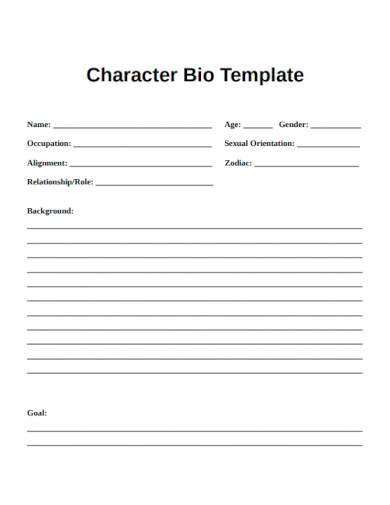
Character Bio Template
download now -
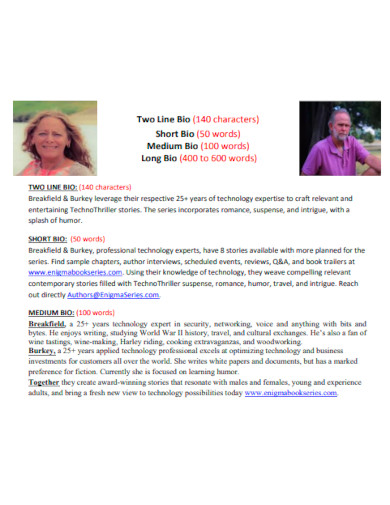
Short Character Bio
download now -
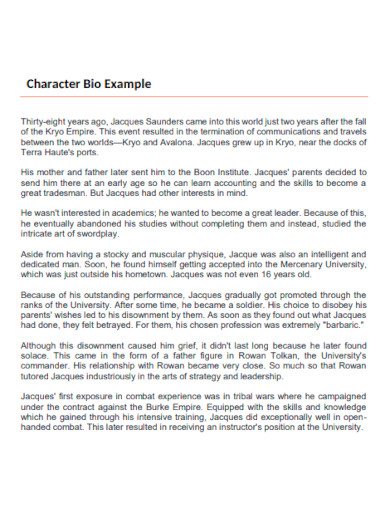
Character Bio Example
download now -
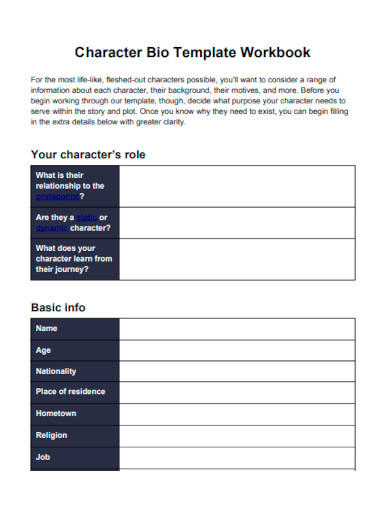
Character Bio Template Workbook
download now -
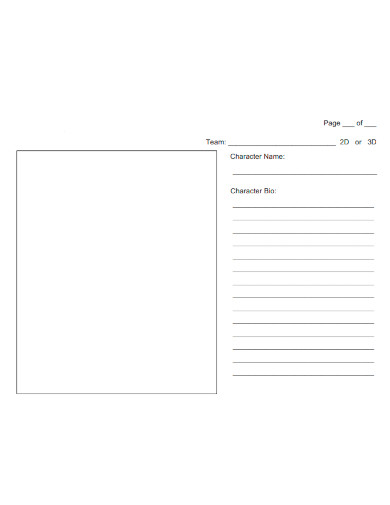
Blank Character Bio
download now -
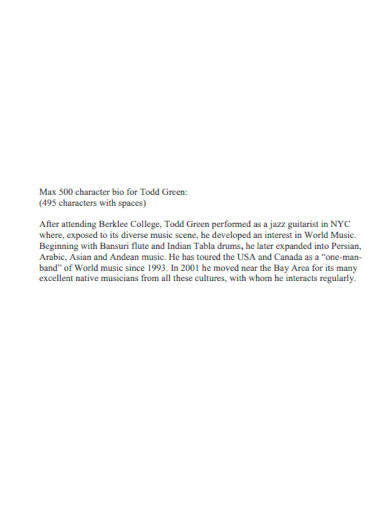
Printable Character Bio
download now -
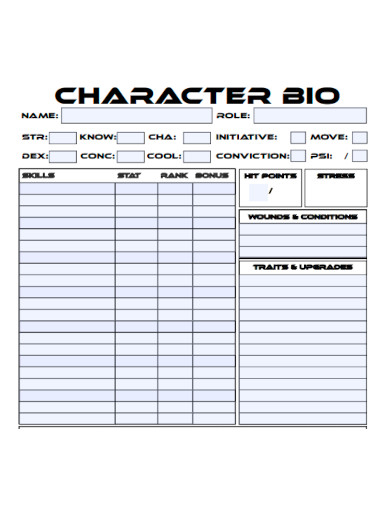
Character Bio Sheet
download now -
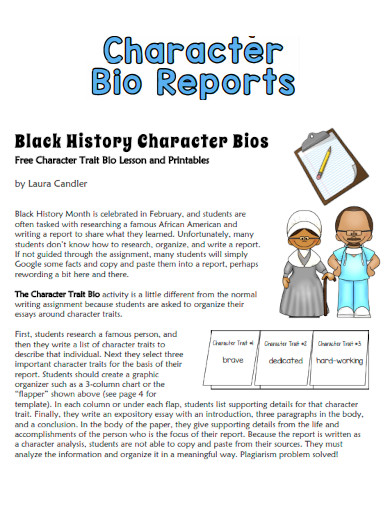
Character Bio Report
download now -
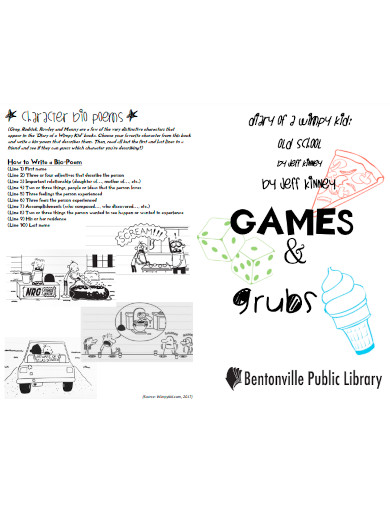
Character Bio Poem
download now -
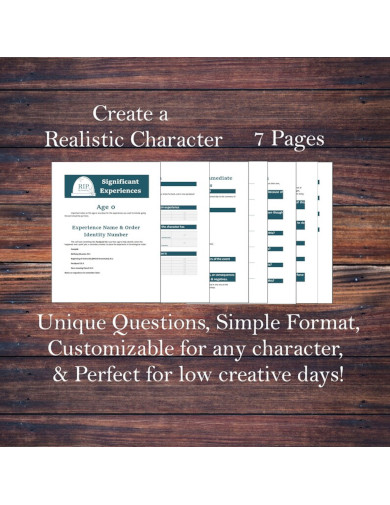
Digital Character Bio
download now -

Character Bio Cube
download now
What Is a Character Bio?
A character bio is a template or document that outlines the biography of a fictional character. The character bio serves as a resource for the writer. It is commonly used as a character template, which includes in-depth questions that emphasize the character’s traits, descriptions, and journey. It helps the author keep track of the character’s personal characteristics, history, and trajectory, which in turn aids the reader in understanding the character’s development throughout the story. Storytellers can paint a vivid picture of the character’s behavior and actions in the narrative by giving a character a past, present, and future. The primary purpose of a character bio is to enhance the realism of the essence, thereby making them more plausible and relatable to the reader. Primarily fiction writers and authors, screenwriters, and other storytellers use character templates. Character biographies should be written for the story’s central characters, protagonists, and antagonists to enhance overall character development.
Benefits of Character Bio
Creating a character bio, or character biography, can benefit freelance writers, actors, game developers, and other creative professionals. It offers in-depth information about the character’s origin, personality, motivations, and other pertinent characteristics. Here are some advantages of creating character biographies:
Tips for Making a Good Character Bio
When expanding character biographies, it can be challenging to consider all the necessary details to create a complete individual. I have compiled tips and techniques to enhance your characters’ stories. If you’re still interested, please continue reading.
1. Personal information
This one is relatively simple. What must we know about your personality? Please give us the police description of who we’re looking at and why they separate from the crowd, including their stature, ideal weight, hair, and personal style. Avoid clichés, such as describing women as hot or beautiful and men as muscular. Sure, if you need to define a superhero, they may be ripped and attractive, but go one step further. What else can we learn about this person?
2. Flaws
This may be conflated with weaknesses, but it is more personal. Perhaps your weakness is kryptonite, but a defect in your character would be a willingness to save everyone but yourself. Consider Peter Parker; his shortcoming is that he prioritizes being a hero over being a child, which causes him to sacrifice many of his relationships. This failure to show up for his peers is a severe flaw in his character. And if we include this information in the character bio, we can construct our narrative, or even future films or television episodes, around this flaw.
3. Know Their Backstory
Everyone has a beginning somewhere. Because we are the sum of our elements, the backstory is essential. Your characters are consistent. Tell us where they came from and when their family, strengths, weaknesses, and faults originated. This should be a summary of all the recommendation letters and an explanation of the character’s current state. Gamora from Guardians of the Galaxy comes to mind. Because Thanos raised and removed her from her devastated planet, she is a ferocious warrior with problems.
4. Why Should We Care?
Seriously. Why? Compassion is the most powerful emotion. It is the link between us and your characters. Every character’s bio requires compassion. We must understand what these individuals are going through to relate to them. Michael Scott was initially a character we disliked, but we soon realized he only desired affection. Michael was an individual who feared dying alone, and who couldn’t relate to that? Once we discovered Michael’s humanity, he entered American households and became one of the most popular characters in history. And this also applies to antagonists. Understanding Killmonger’s intentions and having compassion for his struggle made Black Panther a more profound film.
5. What Do They Wish For?
Your character’s actions are motivated by their desires. They may be the most critical aspect of a character’s bio. We watch your program or film to see your characters accomplish their objectives. Knowing what motivates them gives your narrative a great deal of purpose. What desires does your character possess? It could be as grand as Thanos’ ambition to govern the universe or as modest as Mud’s desire to get his boat running.
6. Do they have a secret?
The final character bio tactic I adore is giving your character a secret. What is something they do not share with the public, or something we could reveal that enhances our perception of who they are? You could use a character secret generator, but getting to know your characters is preferable.
How to Develop Good Personality and Attitude
Your personality is always with you, like your shadow. The good news is that you can always strive to improve your character. We’re all works in progress, so why not put forth the additional effort? Numerous individuals inquire about how to develop a positive demeanor and attitude. Well, it cannot happen overnight; continual effort is required. How to enhance your personality is simple and achievable with our five suggestions. Continue reading and take file notes. In today’s extremely competitive world, the relevance of Personality Development cannot be overstated. A person with a good personality manages work and family with the uttermost grace and leads a good life.
1. Imitate How Your Role Model Conducts Himself
Possessing a role model is always advisable. Observe how they carry themselves. Observe how they communicate, their body language, how they dress, their accouterments, and their overall demeanor. You can develop a cheerful personality and attitude by taking cues from others and adopting their behavior.
2. Develop Your Communication Abilities
Your communication style reveals a great deal about your personality. Make an effort to enhance your verbal and nonverbal communication abilities. Consider your diction, tone of voice, and nonverbal cues such as hand movements, gestures, eye contact, etc. This may seem insignificant, but when you put in the effort to develop your communication skills, you’ll see its significant impact on your demeanor. The relationship between openness and honesty in communication and morale is direct. This can strengthen employee bonds and create a more positive work environment. Employees who communicate freely with their coworkers and superiors are more satisfied with their work environment.
3. Dress Crisp
It is only sometimes necessary to empty your wallet to appear fashionable. It is how you conduct yourself that is important. Even when styling simple items, be sure to add a glamorous touch. Carry a stylish purse, don a bold accessory, and complete your ensemble with elegant footwear! Be fashionable in your manner. Often, your appearance is the first thing that others observe about you. Dressing can aid in making a favorable impression in the workplace. This is essential during interviews and meeting agenda with senior-level managers who make hiring and promotion assessment decisions. If you believe a specific cut or style complements your physique, go for it. Avoid becoming a fashion victim. Your character is as distinctive as you are! This is one of my top personality development recommendations for women.
4. Recognize Your Assets and Rely on Them
I know my assets and strive to highlight them in my personality. It adds a unique accent to make you and your work a limited edition. This does not mean we should ignore our vulnerabilities. For example, one of my most significant vulnerabilities was my short temper. The past year, however, I have made a concerted effort (yes, it’s been difficult at times) to be more patient with myself and others. It has positively reflected my personality and is a work in progress. This is one of the numerous helpful suggestions for employees’ personality development.
5. Make Yourself Known
Brand yourself appropriately – at the right location, among the right individuals! When encountering new people, you observe many characteristics; try incorporating positive traits into your personality. Make your talent, your individuality, and your identity known. You are your most excellent form of advertising. Never undervalue your abilities. You never know how many people would like to be in your position. Always hold yourself in high regard so that others will do so.
FAQs
How do you start a character bio?
Start with a clear concept of your character’s construction, including who they are and their role in the story. Understand your character’s motivation, primary objective, purpose, and defect. Start by completing the fundamental section of the character bio template. Clarify the physical characteristics of your character.
How many characters is a short bio?
Writing a bio is a tedious task that nearly everyone dreads. The standard brief bio is 50 to 75 words (typically 3 to 4 sentences or 400 characters) that describe who you are and the value you bring to your field.
What does a short bio look like?
To compose a brief sample biography, you should introduce yourself in the first or first person. Your short bio should include your brand, achievements, values, and objectives. Your brief bio should contain one to three paragraphs or four to eight sentences.
A character bio template can help you understand all aspects of your characters, giving you a sense of how they may react to the pressures of upcoming event schedules. With a clear understanding of a character’s identity, values, and fears, the reader can appreciate the significance of narrative possibilities, and your story will have more impact. With the preceding information, are you prepared to compose your character bio? Try one of our templates if you answered yes!
